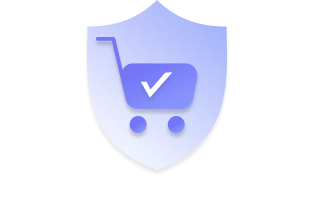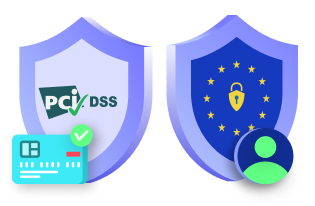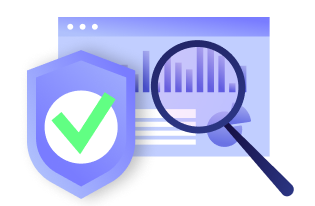Are you putting your e-commerce website’s security at risk? E-commerce stores are exciting and lucrative business opportunities. However, they also face several risks: data breaches being one of the greatest. To ensure that your business is a success, it is essential to factor this into your business plan and efforts because 29% of the traffic that your website receives has malicious intent. If you do not put sufficient security measures in place to prevent these hackers from carrying out their intentions, you are putting your customers and the future of your business at risk. To prevent this from happening, follow these 10 golden tips for e-commerce security.
Ensure a smooth launch for your e-commerce website with this five-part pre-launch checklist [free download].
Common e-commerce security system threats
One of the biggest challenges in cybersecurity is that there are many different types of threats, which continue to grow as cybercriminals become more and more sophisticated. Some of the most common attacks are:
- DDoS – A distributed denial-of-service (DDoS) attack is a malicious attempt to disrupt your website’s normal traffic by overwhelming it. This can be done by sending a large number of requests in a short amount of time.
- Brute force – This is a hacking method that utilizes trial and error to crack encryption keys, login credentials, and passwords. It can be used to break into systems, software programs, or databases.
- Spam – Spam is a form of unwanted advertising that can happen when someone infiltrates your website with comments, content, and links back to their own.
- XSS – Cross-site scripting (XSS) is an attack where a trusted website is injected with malicious scripts. The attacker injects the code, and the target website is unaware that an attack has occurred.
- Phishing – Phishing is a type of cyberattack where a hacker tries to trick someone into doing the ‘wrong thing,’ such as directing them to a malicious website or clicking on a link that will download malware into their system.
- Bots – An Internet bot is a computer program that runs on a network and performs certain actions automatically. These actions include attempting to break into user accounts, chatting with users, or crawling web pages.
- SQL injections – Injection is a hacking technique that affects your website’s database. The hacker injects malicious code into the site’s SQL statements. This code can then be used to manipulate the database and steal information from it.
Manage cookie consent on your e-commerce store
Comply with major privacy laws like GDPR & CCPA with CookieYes cookie consent manager.
Try for Free
*14-day free trial *Cancel anytime
Top 10 tips for e-commerce security
Now that you have a better understanding of some of the most common e-commerce security threats, let’s take a look at 10 of the rules to follow so you can learn how to stop online fraud and prevent other prevalent security issues.
#1 Update your websites and plugins as soon as prompted
When a company releases an update for its plugins (or software), it is making important changes that typically include fixing security vulnerabilities. Therefore, every day that you go without updating your program is a day that you are putting your website at risk. Therefore, it is vital to update your website and any plugins you use whenever you become aware of any updates. It is also a good idea to set periodic updates as well to keep on top of things.
#2 Employ multi-layered security
There is no singular solution that can solve all of your security problems. However, adopting a multi-layered approach can provide better protection. This means using different strategies to protect yourself from hackers, including encryption and the use of firewalls. To ensure those strategies work effectively, though, you need to keep them updated regularly so they can cope with today’s increasing threats.
#3 Invest in regular penetration testing services
Penetration testing is also known as ethical hacking. It is the practice of hacking into your system to find any potential vulnerabilities that could be exploited by criminals. This will enable you to identify vulnerable areas that may need patching up, and make changes before someone exploits them and breaches your system.
The most secure e-commerce businesses make sure they invest in regular penetration testing services so that they can ensure the security of their e-commerce store and deal with any new issues that arise quickly.
#4 Enable multi-factor authentication
It is highly recommended to implement multi-factor authentication for all of your customers, as well as employees that have access to your website management system. Multi-factor authentication means that people have to pass at least two security tasks to gain access to something.
The first step is usually inputting their password. It is followed by an extra layer of security to ensure that hackers cannot carry out brute-force attacks by knowing someone’s username and password. This second step can be many different possibilities, such as a code sent to the person’s phone or email or answering a security question.
#5 Train your employees and enforce the use of strong passwords
it is important to ensure that your employees are aware of the importance of cybersecurity and their role in keeping your e-commerce store secure. This is especially true when you consider that insider threats are the cause of 6 out of 10 data breaches. While malicious employee attacks do occur, most data breaches happen because employees have made a mistake. It is an error to assume that your employees know how to create strong passwords or spot phishing attacks; instead, you should give them the tools they need to protect your e-commerce store.
#6 Switch to HTTPS
When you go to a website, you will see that most start with https:// nowadays. If your website doesn’t, it’s time to change that. The Hypertext Transfer Protocol (HTTP) is a basic communication protocol that both web browsers and servers must implement to communicate with one another. However, HTTP became vulnerable to security concerns because the information is transferred in clear text (unencrypted) over the network. HTTPS was introduced to solve this problem, enabling clients and servers to establish an encrypted communication channel first.
#7 Monitor your website for suspicious activity
There are several tools and plug-ins you can use to monitor suspicious activity on your website. Some of these tools may alert you when:
- Your site experiences an unexpected surge in traffic
- A user is trying to check out with a card registered to a different country
- Someone making a large number of orders in a short space of time
These are all examples of activity that can appear suspicious. An effective tool will alert you when possible fraud occurs.
#8 Set access roles
A lot of businesses make the mistake of granting all employees equal access permissions, which can result in some people having the power to do everything from editing the homepage to interacting with customers and viewing confidential payment information.
Rather than giving everyone full access, restrict access based on the team member’s role within your business. This will ensure that people are able to only have access to the parts of the e-commerce system that they need.
#9 Use an SSL certificate
An SSL certificate is a digital certificate that authenticates a website’s identity and ensures an encrypted connection. You should make sure your business has an SSL certificate, as it will protect all of the sensitive information on your site and have a positive impact on your site’s search engine ranking.
It will also help you satisfy PCI DSS requirements and affirm your corporate identity while improving customer experience.
#10 Choose a secure web host
Finally, choosing the right web host will be instrumental to how secure your e-commerce store is. Web hosts need to limit who can access virtual machines and restrict access to servers.
If you select a host that does not provide enough cybersecurity protection, hackers will find it a lot easier to hack their servers in comparison to the servers other hosts are running. Therefore, you need to take the time to choose a host with care. Choose a hosting provider with a long track record and a good reputation to support it. Carry out due diligence to find out whether the company has been involved in any incidents before.
There is no denying that cybersecurity is a necessity for e-commerce store owners. Following these 10 tips will go a long way to keeping and protecting your e-commerce website’s security and reducing any risk of a data breach.
Author bio: Kerry Leigh Harrison is a content writer who has been creating engaging content for companies around the world for over 11 years. She graduated from university with a First Class Honors Degree in Multimedia Journalism. When she’s not working, she loves attending music and sports events.
Disclaimer: This article is for general informational purposes only and should not be taken as legal or professional advice. The views and opinions expressed in this article are solely those of the author and do not necessarily reflect the views of our organization. We do not endorse any products or services mentioned in the article.








